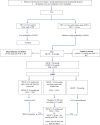Portopulmonary Hypertension: An Updated Review
- PMID: 37492078
- PMCID: PMC10365198
- DOI: 10.1097/TXD.0000000000001517
Portopulmonary Hypertension: An Updated Review
Abstract
Portal hypertension may have major consequences on the pulmonary vasculature due to the complex pathophysiological interactions between the liver and lungs. Portopulmonary hypertension (PoPH), a subset of group 1 pulmonary hypertension (PH), is a serious pulmonary vascular disease secondary to portal hypertension, and is the fourth most common subtype of pulmonary arterial hypertension. It is most commonly observed in cirrhotic patients; however, patients with noncirrhotic portal hypertension can also develop it. On suspicion of PoPH, the initial evaluation is by a transthoracic echocardiogram in which, if elevated pulmonary pressures are shown, patients should undergo right heart catheterization to confirm the diagnosis. The prognosis is extremely poor in untreated patients; therefore, management includes pulmonary arterial hypertension therapies with the aim of improving pulmonary hemodynamics and moving patients to orthotopic liver transplantation (OLT). In this article, we review in detail the epidemiology, pathophysiology, process for diagnosis, and most current treatments including OLT and prognosis in patients with PoPH. In addition, we present a diagnostic algorithm that includes the current criteria to properly select patients with PoPH who are candidates for OLT.
Copyright © 2023 The Author(s). Transplantation Direct. Published by Wolters Kluwer Health, Inc.
Conflict of interest statement
The authors declare no funding or conflicts of interest.
Figures



References
-
- Navarro-Vergara DI, Roldan-Valadez E, Cueto-Robledo G, et al. . Portopulmonary hypertension: prevalence, clinical and hemodynamic features. Curr Probl Cardiol. 2021;46:100747. - PubMed
-
- Savale L, Watherald J, Sitbon O. Portopulmonary hypertension. Semin Respir Crit Care Med. 2017;38:651–661. - PubMed
-
- Savale L, Guimas M, Ebstein N, et al. . Portopulmonary hypertension in the current era of pulmonary hypertension management. J Hepatol. 2020;73:130–139. - PubMed
Publication types
LinkOut - more resources
Full Text Sources

